WILD BIRD SURVEY
17 January 2011 I'm sick of wasting money on bird food that they don't eat! This is a survey of what birds do or do not eat in my garden, in rural Somerset, UK. My objective is to learn what food best suits the wild birds in my garden - and my wallet. There are 3 questions I need to answer.
- Which brand of mixed seed do the birds prefer?
- Would I be better off buying separate seeds?
- If so, which seeds are preferred?
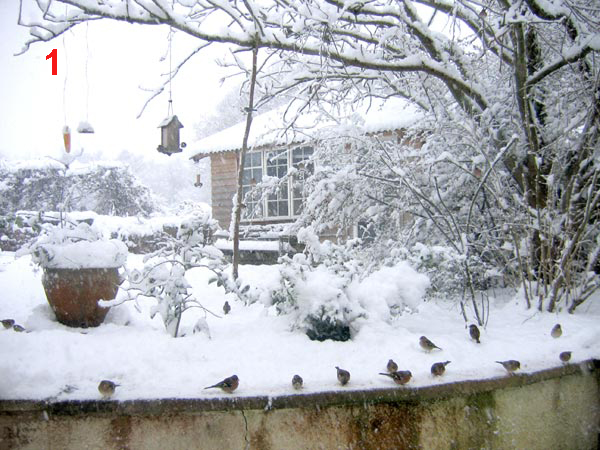
In December 2010 we had unusually cold weather. Birds were tempted to feed in my garden in large numbers. [See 1 above.] The bulk of the food is placed in feeders, but in the image above food was spread along the top of the low wall. No sooner was this done than it was covered by subsequent snow falls. To solve the problem I swept a bit of path clear, placed a glass topped table over it and scattered bird seed under. The food in question was Harrison's All Seasons Wild Bird Food. I was rather surprised to note at the end of the day that the bulk of the food remained uneaten in spite of the very harsh weather. There had been plenty of birds hopping around and pecking and scratching at it, so they were not deterred by the table looming overhead etc. Image 2 below is of the uneaten food.
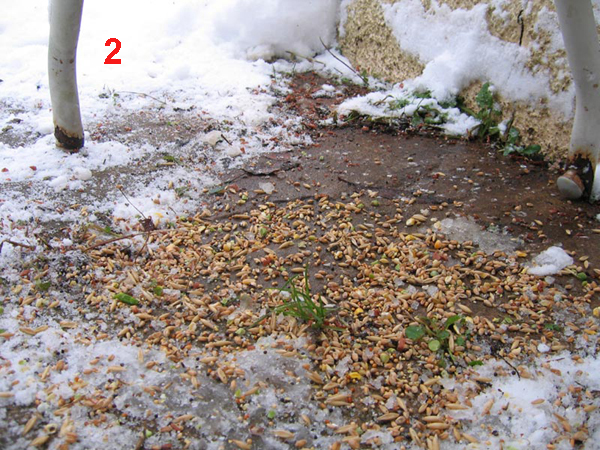
Among the uneaten seeds were wheat, oats, peas, maize, and various small round seeds resembling yellow and red millet and rape. Wheat predominated.
Below is a list, in no particular order, of birds that are commonly seen on or around seed feeders in my garden. The operative word is 'commonly'; a week or so ago I saw a Great Spotted Woodpecker - Dendrocopos major - on a seed feeder, but I think it was just investigating. It normally confines its efforts to the peanuts.
- Blackbird - Turdus merula
- Blue tit - Parus caeruleus
- Coal tit - Parus ater
- Great tit - Parus major
- Chaffinch - Fringilla coelebs
- Greenfinch - Carduelis chloris
- Dunnock - Prunella modularis
- House sparrow - Passer domesticus
- Robin - Erithacus rubecula
- Starling - Sturnus vulgaris
- Wood pigeon - Columba palumbus
- Collared dove - Streptopelia decaocto
- Pheasant - Phasianus colchicus
I use mainly two sorts of feed; peanuts and seeds. As I am only concerned with seed I have listed above only those birds that show an interest in seed as opposed to those which only show an interest in peanuts or other food. For example, although bullfinches - Pyrrhula pyrrhula - regularly visit my garden I have never seen them on the seed feeders in spite of them being featured prominently on the packaging of Harrison's All Seasons Wild Bird Food. On 27 Jan 2011, on two separate occasions, I spent 5 minutes watching a female bullfinch gorging on Amaryllis shoots less than two feet from a seed feeder receiving heavy traffic from other birds. The bullfinch completely ignored the seed in the feeder and the spilled seed on the ground. Image 3 shows a random sample of 4 oz of Harrison's All Seasons Wild Bird Food.
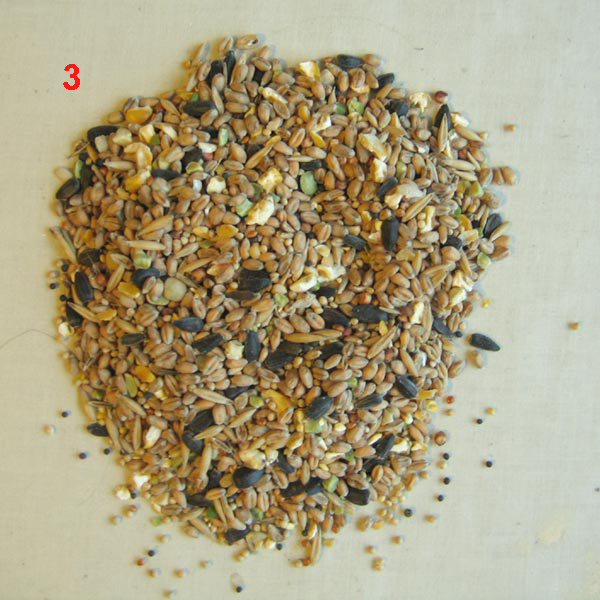
I sorted the above sample into its various constituent grains; image 4 shows the above sample after sorting - testimony that I need to get out more. Starting from top left and going clockwise I have identified the seeds as follows; black sunflower; unidentified 'grasses' and dross; split peas; mixed rape and red and yellow millet and possibly other small seeds; red dari; pinhead oats; and cut maize. In the centre is wheat.
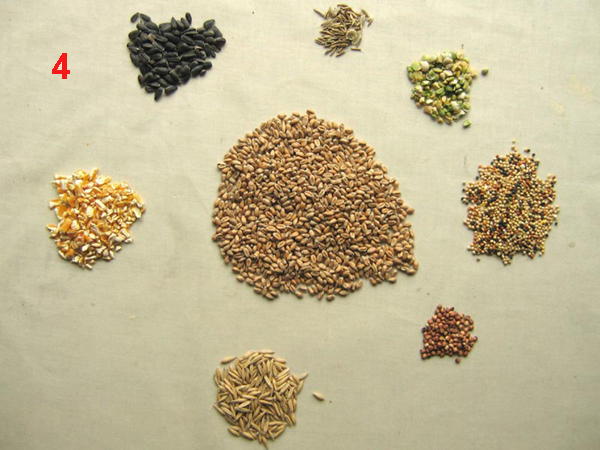
The above sample contained approximately the following weights and percentages of seeds. [In case anyone is counting they were weighed in identical bags. 8 bags weigh slightly under ½ oz.
- 2½ oz wheat = 55%
- under ½ oz rape, millet = under 11%
- under ½ oz maize = under 11%
- ¼ oz peas = 5.5%
- ¼ oz black sunflower = 5.5%
- ¼ oz oats = 5.5%
- under ¼ oz red dari = under 5.5%
- under ¼ oz dross = unde
At the time of writing 20 kg of Harrison's All Seasons Wild Bird Food costs £11.34 which is slightly under 57 pence per kg. My guess at this stage is that at least half the feed is uneaten. So the food the birds eat actually costs about £1 per kg. At time of writing, bought by the sack-full, I was quoted the following prices for unmixed grain by the same supplier of the bird seed;
- wheat = 31 p per kg
- maize = 38 p per kg
- peas = 44 p per kg
- black sunflower = £1.12 p per kg
- oats = 34 p per kg
I was unable to get prices for the other seeds. In effect, at the above prices and percentages each constituent seed in the All Seasons mix is priced up to approximately £2 per kg or 6 to 7 times their price if bought separately.
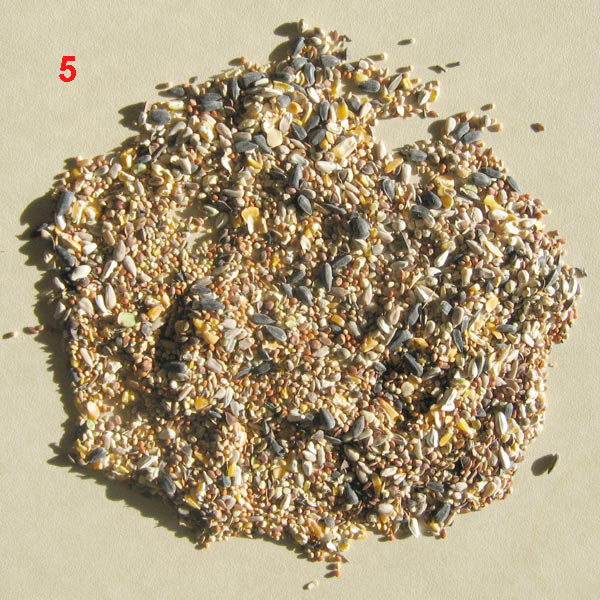
24 January 2011 In an attempt to get a seed mix containing a greater proportion of seeds that the birds might be willing to eat I bought a sack of Harrison's 'Premier Wild Bird Mix'. [Harrisons are not my bête noire; their's is the only bird seed the retailer stocks.] Image 5 above shows another random 4 oz sample of 'Premier'. Image 6 below shows what was on the ground first thing this morning before re-filling the feeder with 'Premier'. The stuff on the ground was not only uneaten by birds during the previous day but also uneaten by rodents overnight. I commonly get; grey squirrels; rabbits; rats; mice. The underlying black stuff is tarmac rather than a mountain of sunflower seeds!
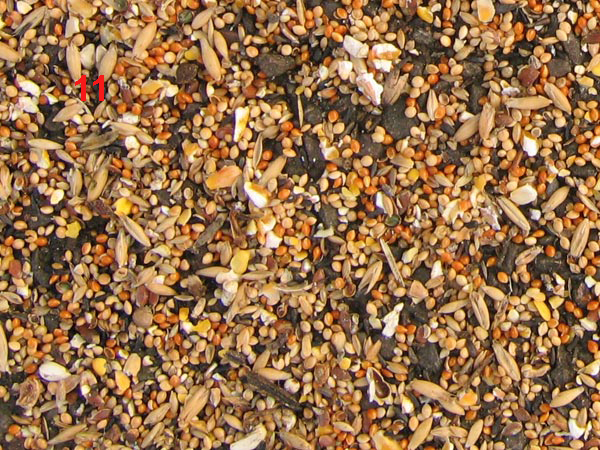
Harrison's Premier Wild Bird Mix claims to contain the following; Cut Maize; Sunflower Hearts; Red Millet; Yellow Millet; Red Dari; Peanut Granules; Black Sunflower; Pinhead Oatmeal; Canary Seed; Linseed; Buckwheat; Safflorseed; Split Peas; Niger Seed; Hemp. Of the above ingredients only Peanut Granules, Canary Seed, Linseed, Buckwheat, Safflorseed, Niger Seed, and Hemp are not represented in the All Seasons mix. I buy peanuts by the sack, so don't need them included in bird seed. I have never seen a canary in my garden. Buckwheat sounds American. I have never heard of Safflorseed or Niger Seed and suspect that the birds in my garden have not either. That leaves Linseed and Hemp. The Premier costs £12.16 for an 8 kg sacks = £1.52 per kilo as against 57p per kilo for the All Seasons.

30 January 2011 My first task is to establish which of the various individual seeds the birds in my garden actually prefer. Needing several small seed feeders and not wishing to do anything to damage the UK balance of trade I made my own. I don't give a hoot for the opinion of either Pigeons or Collared Doves so wanted a feeder that would hopefully deter them and larger birds from feeding from them. One picture being worth a thousand words, I made these;
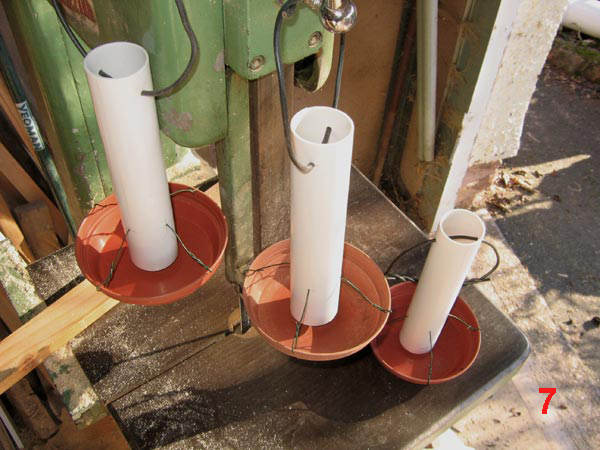
The tubes are about 8” long and 1½” diameter - ex standard plumber's plastic waste pipe. The bottom ends of the tubes are held about ½” clear of the dishes - 5” flower-pot dishes. As feed is taken from the dish it is replaced by gravity from the tube until the tube is empty. FILLING TIP! pour seed into the dishes first to cover the bottom of the tube to avoid spillage filling via the top of the tube. Here they are filled.
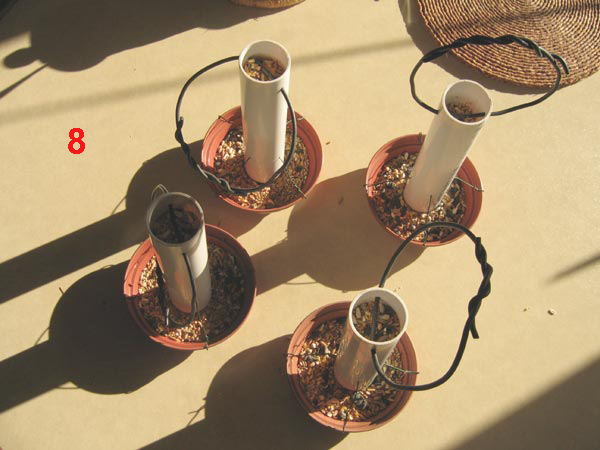
To start with I have filled them with Harrison's 'Premier' wild bird seed to habituate the birds to feeding from new feeders in a different place from normal. Image 9 shows the new feeders in situ awaiting customers. There will be no laundry done for a bit!
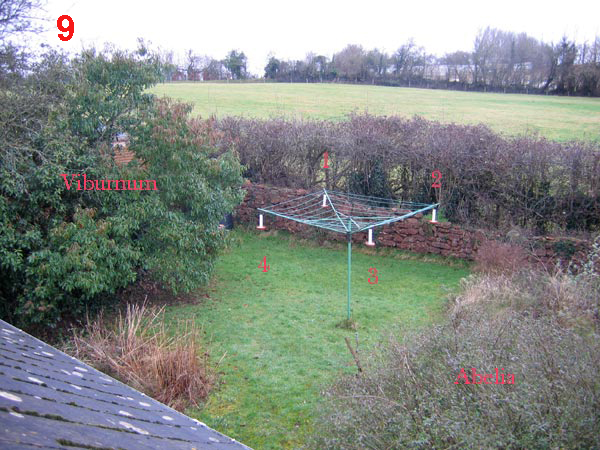
Ever inquisitive Blue Tits were first to inspect. They began their investigations within an hour of the feeders being put in place. By the end of the first afternoon the feeders were also visited by Great Tits and a Robin. A Blackbird took advantage of spillages. I shall continue to feed mixed seed until the new feeders are as popular as the old ones - i.e. emptied in a day. I will then fill each with a separate single seed type to see which is preferred.
Q. Should the feeders be filled by equal weight? or equal volume?

4 February 2011 So far, since introducing the new feeders, swarms of Blue Tits, a few Great Tits and the occasional Robin have actually fed from them directly. Timid Chaffinches and a rabble of Sparrows have scratted about beneath the new feeders in company with the Black Birds, Pigeons and the odd Dunnock. But today, I have seen a female Chaffinche overcome her timidity to venture onto the feeders. The message seems to be getting through!
However, I foresee a slight difficulty looming. The Sparrows etc on the ground are presumably eating seed spilled from the new feeders above them. [They were never in such numbers around the washing line until I put the new feeders in position.] I can see Blue Tits etc turfing stuff over-board from the new feeders with the abandon of Joshua Slocum jettisoning his alarum clock. Here, after a week, is what the birds think of Harrison's 'Premier' bird food being fed from an old feeder at the front of my property.
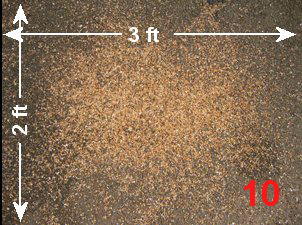
So, just because the birds empty the feeders does not mean that they are necessarily eating the contents. How will I know, come the seed trials, whether the birds are eating the millet for example, or just mining it in search of sunflower? The new feeders, positioned over grass, have the same feed as the old feeder beneath which is the heap of rejected seed shown in the image at left and in a close-up below. The rejected seed includes; yellow and red 'millet', rape, red dari, oats, peas and maize.

If you compare these two images with image 6 [see under 24.i.11], you'll notice that the rejects have now almost totally obscured the tarmac. If nothing else, I should end up with having some interesting stuff to mow later in the year.

5 February 2011 At the end of nearly a week the regulars at the new feeders remain Blue Tits, Great Tits, an occasional female Chaffinch and a Robin. Only one Robin seen at a time, with no opportunist rival seen lurking so I suspect it is the same individual. Likewise the female Chaffinch; an increasingly regular visitor on the feeders but again, I have only ever seen one at a time. Her female companions and all the males remain earthbound. There are occasional Coal Tits as well. STOP PRESS! I can now add Greenfinch to the list. This is particularly gratifying; having been plentiful till a couple of years ago, they have been in short supply of late. There are at least two.
The birds do not appear to have a preference for any one of the 4 feeders but they land least frequently on whatever feeder is at position number 3 - see image 9. The birds assemble mostly either in the hedge or the Viburnum. They seem to head for the nearest feeder from wherever they are perched. If the wind does not see to the random distribution of feeders I see to it occasionally myself. It's a hard life.
As soon as I can lay my hands on a supply of separate seed I shall begin the single seed preference trial. I will need 1 kg of each of the following; wheat, oats, crushed maize, crushed peas, millet, sunflower, and red dari. I will also use crushed peanuts as a control. I know the birds eat that! All that is holding me up is a supply. If you know anyone who can supply wheat, oats, crushed peas, millet, or red dari in amounts smaller than whole sacks full I would be interested to have their name, phone number etc. None of the pet or agricultural suppliers round here [west Somerset] seem able to supply me.

7 February 2011 Another Monday. Nothing much to report. Still feeding mixed commercial bird seed while awaiting supply of separate seed. I have made 2 slight modifications to the new feeders neither of which appears to have deterred the birds; I have numbered each feeder and given the tubes feet so they are all retain the requisite ½ inch clearance rather than rely of the tubes being kept the correct distance off the dishes by the wires alone. [See below.]
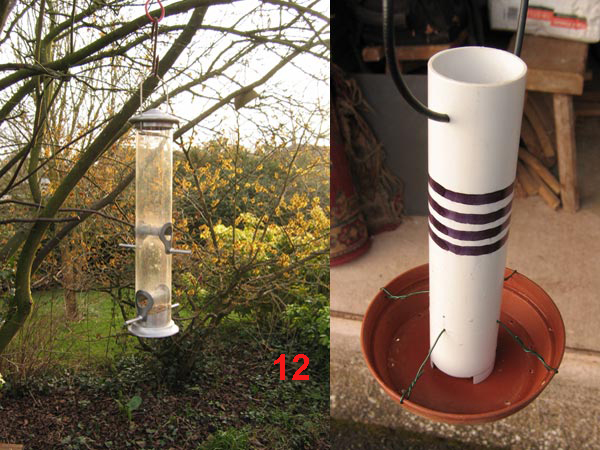
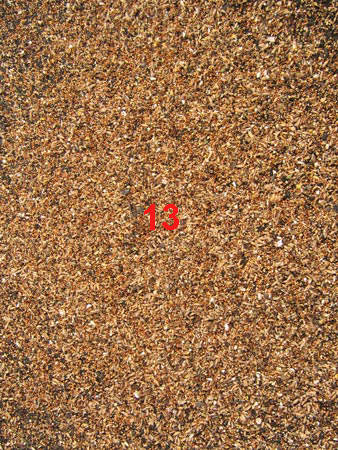
I have seen a male House Sparrow on the feeders - whether more than one I'm not sure - but no females. Whereas the female Chaffinch/s continue to be regular feeders on the new feeders, males will occasionally approach the new feeders but not land, preferring to tread water frantically before either flying off in a funk or snatching at a morsel, retreating and eating. Meanwhile the grain mountain continues to accumulate under the old feeder and now completely obscures the tarmac as shown at left. Not even the rodents eat it!
It rained this morning - enough to wet the grain in the dishes. This does not seem to have put the birds off, unlike wet peanuts. But I will drill small drainage holes in each dish tonight when I bring them in after dark, otherwise the dishes might fill with water and that could be a problem. More importantly the tubes need caps. The rain wet the grain in the tubes either making it swell or increasing its adhesion to the sides of the tubes. Either way, grain from the tubes was more resistant to filling the dishes than before. Each of the new feeders holds about a ¼ of my other 'standard' double-decker feeders [see above - at left of image 12]. Birds empty the old feeders in about a day but the old feeders can only accommodate 4 birds at a time, whereas the new feeders [at right in image 12] can each accommodate at least 2 birds a piece. So if the new feeders are not emptied as quickly or quicker than the old ones, something is amiss.

14 Febuary 2011 "Whan every foul cometh there to chese his make" the birds in my garden were as reported above save only that male chaffinches and female sparrows now venture onto the new feeders occasionally. But they and Dunnocks and the larger birds - Blackbirds and upwards - continue to feed mainly off the ground. This is the same as with the conventional older feeders. I am continuing with the mixed feed for the moment while I make 'new' new feeders which for the sake of clarity I will call 'pipe' feeders. The ones shown above with dishes definitely suffer in the wet. Regardless of the drainage holes, when it rains the grain in the dishes gets wet which transmits moisture to the seed at the base of the tubes and effectually blocks dry seed from descending out of the tube onto the dish.
Below is an image of 2 pipe feeders, neither of which is right yet. Both suffer somewhat from the same defect; the outlet feeder holes are too small. The problem is obtaining the right diameter fittings. Plastic pie manufacturers seem to bear no thought for those of us wishing to construct bird feeders, so their pipes do not come sized in small enough increments to suit anyone but plumbers. The holding tubes of those below, and their cap and base fittings, are 50 mm whereas the feeder hole parts are 22 mm. What I really need are 25 - 30 mm parts for the feeder holes. The difficulty is keeping the parts small enough not to compromise the strength of the 50 mm components while being big enough to function effectively as seed outlets.
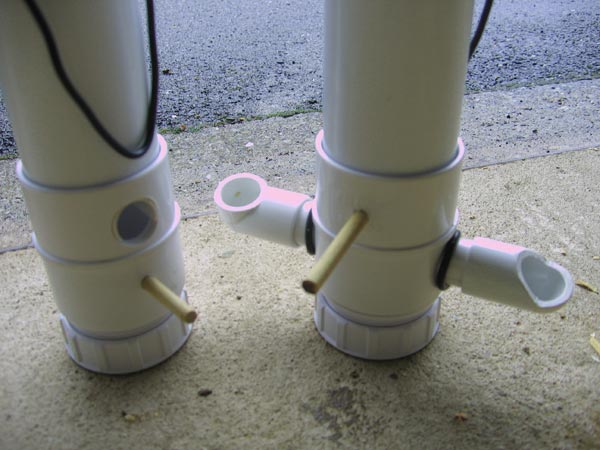
Construction is simple. All the pieces are held in place without glue, but I may have to glue the feeding shoes in place in the model at right in order to get them closer to their supply of grain from the pipes. At present they do not fill very well. Nor is it very water proof! Hey ho the wind and the rain. Of the two different shoe types above right, that to the right proved better as enabling birds to reach further in than the cup to the left. Neither are proof against rain.

